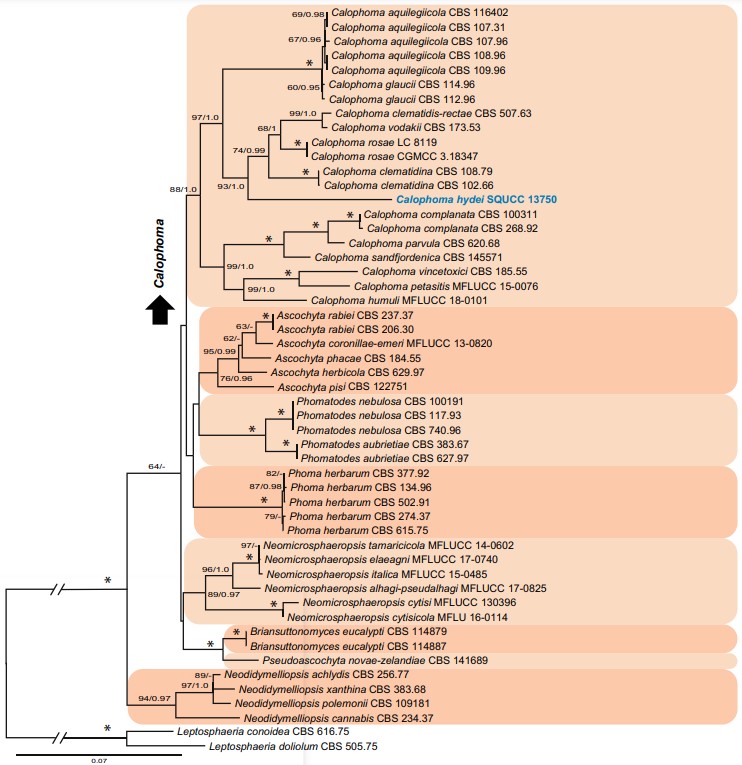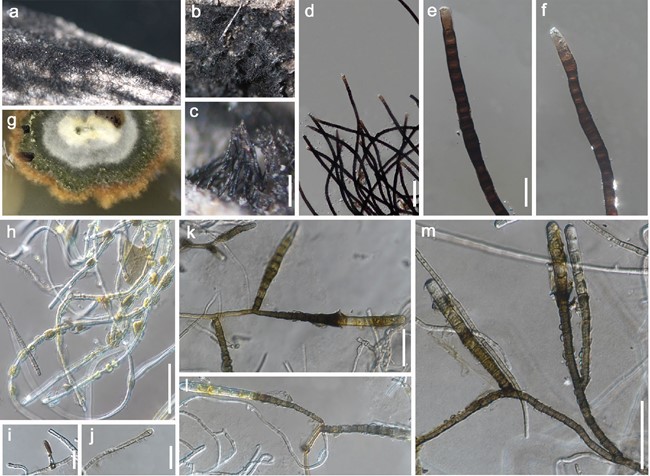Desertiserpentica hydei Maharachch., Wanas. & Al‑Sadi, sp. nov.
MycoBank number: MB 837556; Index Fungorum number: IF 837556; Facesoffungi number: FoF 09485; Fig. 16
Etymology: Named in honour of British mycologist K.D. Hyde, for his huge contributions to ascomycete taxonomy.
Colonies growing saprotrophically on natural substrate, superficial, effuse, hairy or velvety, dark brown, grey or black. Mycelium partly superficial, partly immersed, composed of branched, septate, smooth, pale brown hyphae. Sexual morph: Not observed. Asexual morph: Hyphomycetous. Conidiophores macronematous, mononematous, simple, cylindrical, septate, branched, smooth, brown, septate, without percurrent extensions. Conidiogenous cells monoblastic, integrated, terminal, cylindrical or doliiform, determinate, brown. Conidia up to 1,100 μm long, 9.5–15.0 μm wide, acrogenous, solitary, flexuous, dry, pale brown to brown, distoseptate 8–14 μm, long cylindrical with rounded apex.
Colonies on PDA moderately growing, reaching 4 cm diam. after seven days at 25 °C, circular, white to olive- green and margin orange or dark brown, with moderate aerial mycelium, margin undulate. Mycelium partly superficial, partly immersed, composed of branched, septate, smooth, pale brown hyphae. Sexual morph: Not observed. Asexual morph: Conidiophores and Conidiogenous cells similar to those on natural substrate. Conidia up to 400 μm long, 8.0–10.0 μm wide, acrogenous, rostrate, sometimes furcate with several arms, olive-green to brown, distoseptate 8–14 μm, long and cylindrical with a rounded apex.
Material examined—OMAN, Nizwa, from dead wood, 25.09.2016, SSN Maharachchikumbura OM21 (SQU H-121, holotype), ex-type living culture = SQUCC 15092.
GenBank accession numbers: LSU: MW077156; SSU: MW077163; ITS: MW077147; TEF: MW075773.
Notes—Desertiserpentica is allied to Dimorphiopsis (Fig. 4), an asexual, unusual monotypic genus associated with leaves of Brachystegia spiciformis (Fabaceae) collected from Zambia (Crous et al. 2013). Crous et al. (2013) were not sure if Brachystegia was a coelomycete or hyphomycete because in pine needle agar it was a hyphomycete, whereas in water agar it behaved like a coelomycete with immersed conidiomata. Dimorphiopsis is characterised by pale to brown, septate, branched hyphae, varying conidiomata from immersed pycnidia to superficial sporodochia and solitary, pale brown to dark brown, 1-distoseptate conidia (Crous et al. 2013). Thambugala et al. (2015) introduced Amorosiaceae, as sister to the family Lophiostomataceae. Two genera, viz. Amorosia Mantle & D. Hawksw. and Angustimassarina Thambugala et al. were accommodated in Amorosiaceae and both genera have hyphomycetous asexual morphs but are clearly distinct from Desertiserpentica.

Fig. 4 Phylogenetic tree inferred using the combined sequences of LSU, ITS, TUB and RPB2 of the analysed Didymellaceae genera. The tree backbone was constructed using maximum likelihood (ML) analysis. The MLB and PP above 60% and 0.95, respectively, are given at the nodes (MLB/PP). An asterisk (*) indicates branches with MLB = 100% and PP values = 1.0. Species are followed by the strain accession numbers. The new strain is indicated in blue bold. The scale bar represents the expected number of changes per site for ML

Fig. 16 Desertiserpentica hydei (SQU H-121, holotype) a–c Appear- ance of colonies on host surface. d–f Acrogenous, solitary, flexuous, distoseptate conidia on natural substrate. g Colonies on PDA. h–m
Conidiophores, conidiogenous cells and conidia on PDA. Scale bars: c = 500 μm, d, h, k, m = 100 μm, e = 20 μm, i, j = 50 μm. Scale bar of e applies to f. Scale bar of k applies to l
